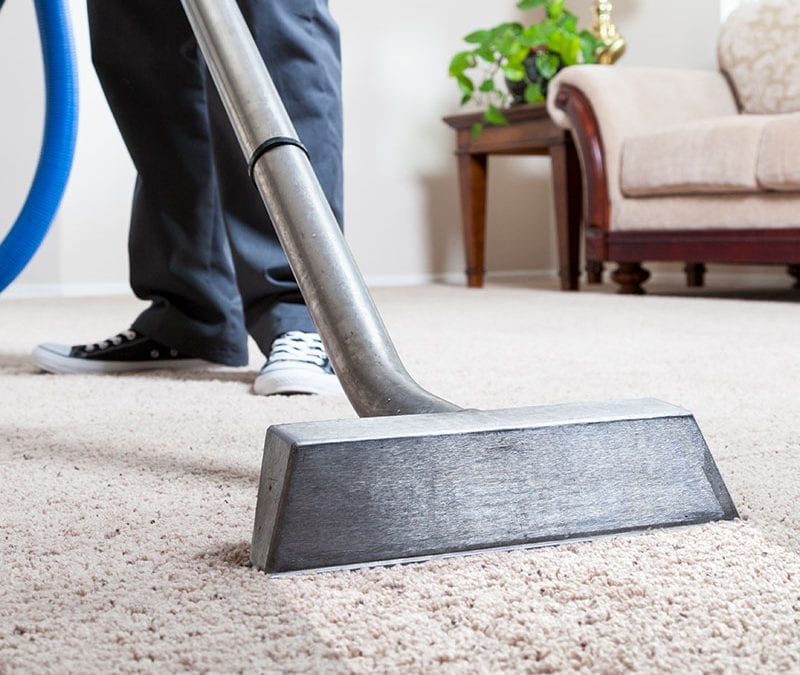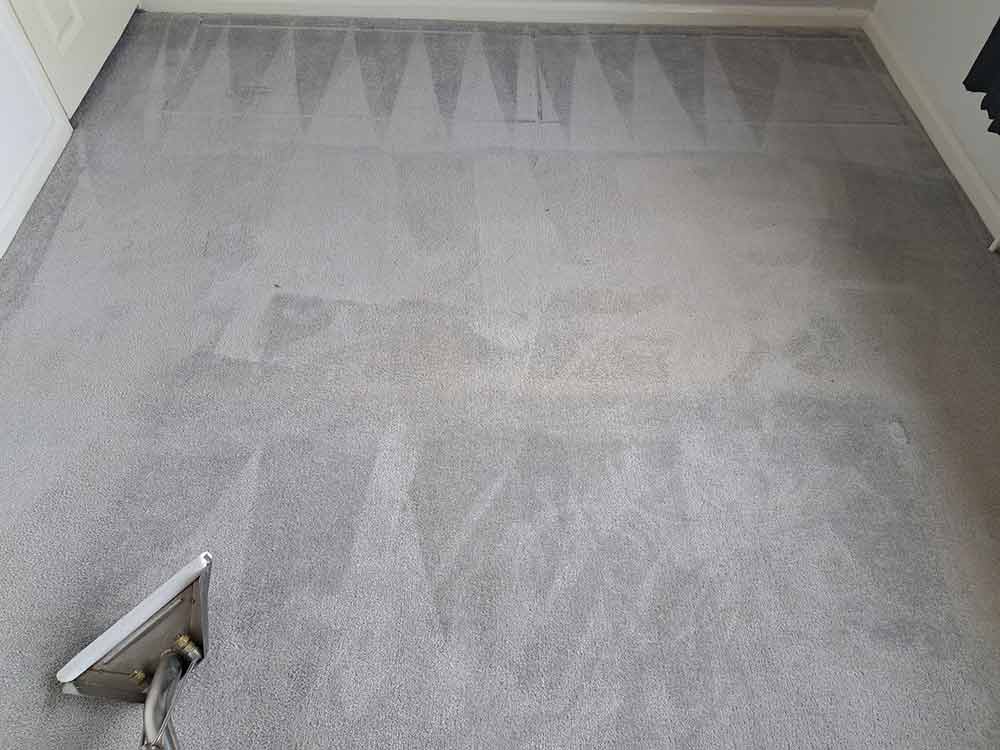You might think pet stains are just a part of life as a pet owner, but they don't have to be a permanent fixture in your home. With the right knowledge and tools at your disposal, you can effectively tackle these challenges head-on. This guide will equip you with practical solutions and techniques to keep your space clean and fresh. Plus, you'll discover how to prevent stains before they happen, ensuring a more harmonious living environment with your furry companions. So, what's the first step you should take?
Understanding Pet Stains
Have you ever wondered why pet stains can be so persistent and frustrating? You're not alone. Many pet owners struggle with stains that seem to cling on no matter what you do.
One common misconception is that all stains are the same; however, they can vary greatly in characteristics. For instance, urine stains contain uric acid crystals, which lead to lingering odors and tough removal challenges. In contrast, tear stains are caused by porphyrin, an iron-containing molecule that can leave unattractive reddish-brown marks.
Additionally, some breeds are more prone to staining due to their facial structure and tear duct issues. Allergies can exacerbate the problem, leading your pet to produce excess tears or saliva, which can also result in stains. Environmental factors, like sunlight, can darken these stains further. Understanding these stain characteristics helps you tackle them effectively. Instead of getting frustrated, focus on the specific type of stain you're dealing with. This knowledge equips you with the right strategies for clean-up and prevention, making pet ownership a bit easier and more enjoyable. Regular use of bio-enzymatic cleaners can significantly aid in breaking down tough stains and neutralizing smells.
Preparation and Safety Tips
Preparing for pet stain cleanup can make all the difference in tackling those pesky accidents effectively. Start by gathering your essential cleaning tools, like cloths, paper towels, and your chosen cleaning products. Having everything at hand saves time and helps you act quickly.
Always test any cleaning product in a hidden area to verify it won't discolor your surfaces.
Safety precautions are vital. Use gloves to protect your skin while handling stains, and read the instructions on any commercial products to guarantee safe use. If you suspect there are invisible stains, utilize a UV flashlight to identify them before cleaning.
Isolate your pet from the area to prevent further accidents while you work.
Remember to wash your hands thoroughly after handling any cleaning products. Good ventilation is necessary, so open windows or doors to avoid inhalation risks. If you accidentally come into contact with your eyes, flush them with water immediately.
Additionally, ensure you have a plan in place for prompt stain removal, as addressing stains quickly can prevent them from setting and becoming difficult to remove.
Acting swiftly and following these preparation and safety tips will help you effectively manage pet stains while keeping yourself safe.
Effective Cleaning Solutions
Once you've taken the necessary preparation and safety steps for cleaning up pet stains, it's time to explore effective cleaning solutions that can tackle those stubborn messes.
You'll find a mix of commercial products, DIY options, and professional methods that offer various stain removal techniques.
For quick results, consider OxiClean Carpet & Area Rug Stain Remover, which works in just 10 minutes. If you prefer something more natural, Angry Orange Pet Odor Eliminator Spray uses citrus to effectively fight stains and odors.
Both products shine in cleaning product comparisons for fresh and set-in stains.
If you're looking for DIY cleaning solutions, a vinegar and baking soda mix can be quite effective. It's safe for carpets and upholstery, breaking down messes and neutralizing odors.
Alternatively, a Dawn dish soap and hydrogen peroxide mixture can penetrate tough stains, although scrubbing is necessary.
For deeper cleaning, professional methods like hot water extraction and enzymatic cleaners can work wonders on older stains. Professional cleaning services utilize specialized solutions that ensure thorough removal of tough pet stains and odors.
Evaluate your options based on the severity of the stain and your cleaning preferences to find the best solution!
Locating Hidden Stains
Locating hidden stains in your home can feel like a challenging task, but with the right techniques, you can uncover those pesky spots left by your furry friend.
Start with a thorough visual inspection and a sniff test in areas where your pet frequently roams. If you suspect hidden stains, employing stain identification techniques like using a UV light can be incredibly effective.
A handheld UV flashlight, such as the Simple Solution Spot Spotter, reveals pet urine stains by making proteins and phosphorus glow. For best results, use the UV light in a dark room and keep it within 24 inches of the surface.
Make sure to vacuum the area first to reduce distractions from other glowing objects. Target specific areas with known odors for a more efficient search.
Don't forget to check carpets, rugs, furniture, and even car interiors, as urine can seep into various surfaces.
While UV light effectiveness is impressive, remember to complement it with your visual and olfactory cues for an all-encompassing search. If you're still struggling with persistent stains, don't hesitate to reflect on professional cleaning assistance. Regular cleaning can help extend carpet lifespan by removing abrasive soils and preventing dirt buildup.
Step-by-Step Cleaning Guide
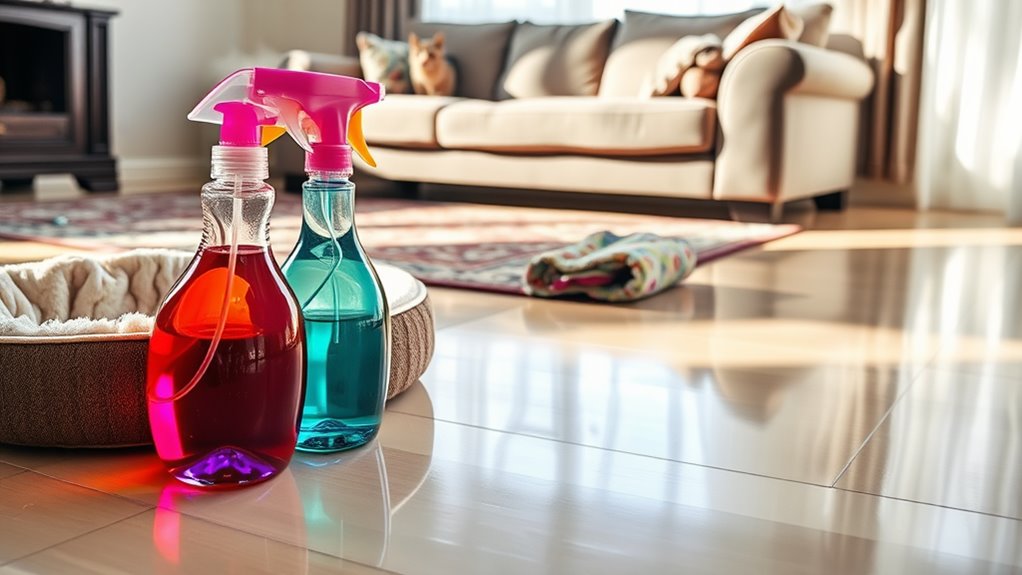
Finding hidden stains is just the beginning; tackling them effectively requires a step-by-step approach. Start by blotting the stain with a clean cloth or paper towel to absorb as much liquid as possible—avoid rubbing, as this can push the stain deeper. If there's solid waste, gently lift it away using a paper towel.
Next, flush the area with fresh water. Saturate a clean microfiber towel and press it into the stain, absorbing waste as you go. Choose an appropriate cleaning solution based on the stain type—enzyme-based cleaners work wonders for pet stains. After applying the cleaner, soak up any excess liquid by repeating the flushing process.
If you're dealing with stubborn stains, consider DIY solutions like a vinegar and water mix or baking soda. These can help lift the stain without harsh chemicals. Remember, cleaning frequency is essential; regular maintenance can prevent deeper stains from forming. Additionally, professional cleaning services can effectively lift many types of stains, but not all, so it's wise to assess your carpet's condition regularly.
Finally, if the stain persists despite your efforts, don't hesitate to seek professional help. They can tackle deep underlying residues and guarantee your home remains fresh and clean, making it a welcoming space for both you and your pets.
Dealing With Older Stains
Dealing with older stains can feel overwhelming, especially when they've had time to settle into your carpets, hardwood floors, or upholstery. However, you can tackle these stubborn marks with the right stain removal methods and cleaning techniques.
For carpets, avoid hot water, as it can set the stain deeper. Instead, reach for enzyme-based cleaners, which effectively break down the proteins in pet stains. A 3% hydrogen peroxide solution can also work wonders—just test a small area first to prevent discoloration.
Don't be discouraged if the stain persists; repeat treatments may be necessary. It's also important to remember that the type of cleaning solution used can significantly impact the effectiveness of stain removal.
When it comes to hardwood floors, a diluted vinegar solution (one part vinegar to one part water) can help clean without damaging the wood. For tougher stains, try a hydrogen peroxide mix of one part peroxide to two parts cool water.
Remember to test any cleaner first, as enzyme-based products can harm unsealed wood.
If you're dealing with upholstery, use a clean cloth to blot stains rather than rub, and consider enzyme-based cleaners or a vinegar-water mix.
Ultimately, for severe stains, don't hesitate to seek professional cleaning services that can offer specialized techniques.
Special Cases for Stains
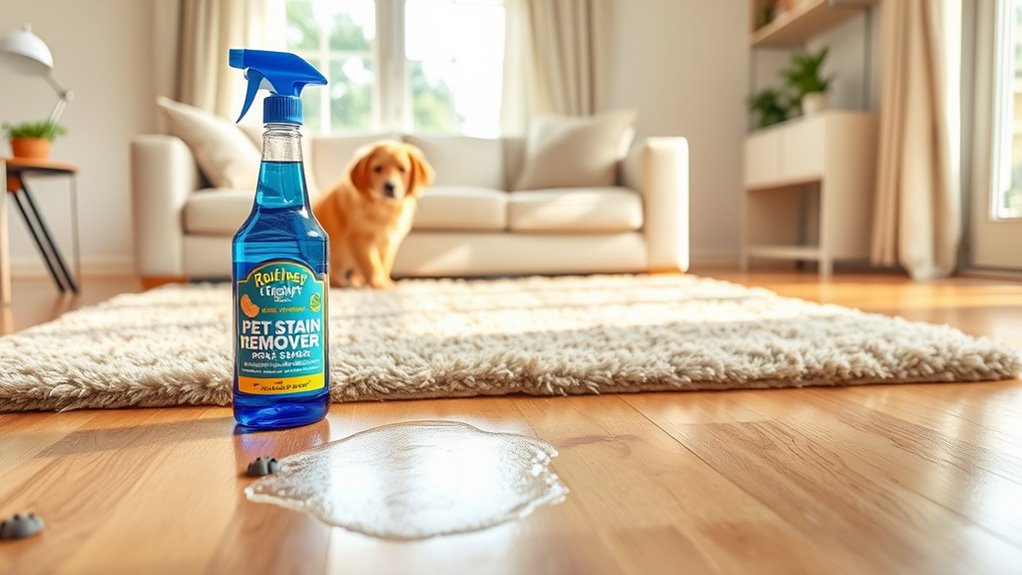
When it comes to pet stains, understanding the specific type can make all the difference in your cleaning approach.
Urine stains, for example, require quick action. Using bio-enzymatic cleaners like Rocco & Roxie can break down ammonia crystals effectively. Remember to remove excess material first and rinse the area with water after cleaning to preserve your carpet's integrity.
Vomit stains also demand immediate attention. The acid in vomit can damage your carpet if left untreated. Enzymatic cleaners can help break down the proteins, but you should remove solid debris before applying the solution. Products like Resolve Ultra work wonders here.
Fecal stains are another special case. These need rapid cleaning to prevent bacterial growth. Bio-enzymatic cleaners like OdorPet can eliminate organic matter effectively. Pre-treat the stain before rinsing, and avoid rubbing to prevent further damage.
Lastly, mud stains may require multiple treatments. Always remove excess mud beforehand and let your cleaning solution sit for about five minutes to enhance its effectiveness. Avoid scrubbing to protect your carpet fibers. Additionally, consider using enzyme-based carpet cleaners for thorough odour elimination and effective removal of stubborn stains.
Prevention and Maintenance Strategies
Preventing pet stains before they happen can save you time and stress in the long run. Start by implementing effective preventive measures. Immediate cleanup is essential; act quickly when accidents occur, blotting up moisture with paper towels before rinsing with cool water.
Establish regular feeding and bathroom schedules for your pets, and reward them for good behavior to reinforce positive habits.
Incorporate daily cleaning habits into your routine. Create a schedule to clean pet areas, using a damp rag to absorb oils and mixing dish soap with warm water for spot treatments. Regularly vacuum carpets to prevent dirt buildup and inspect them for hidden stains—this helps maintain a clean environment and discourages marking.
Make household adjustments by utilizing machine-washable items and placing newspaper under pet areas to absorb spills. Consider using enzymatic cleaners to tackle odors effectively. Additionally, maintaining cleanliness through regular carpet cleaning can significantly improve indoor air quality and overall health.
Finally, don't hesitate to seek professional assistance for deep-seated stains. By taking these steps, you not only prevent stains but also create a healthier living space for both you and your pets.
Eco-Friendly Cleaning Options
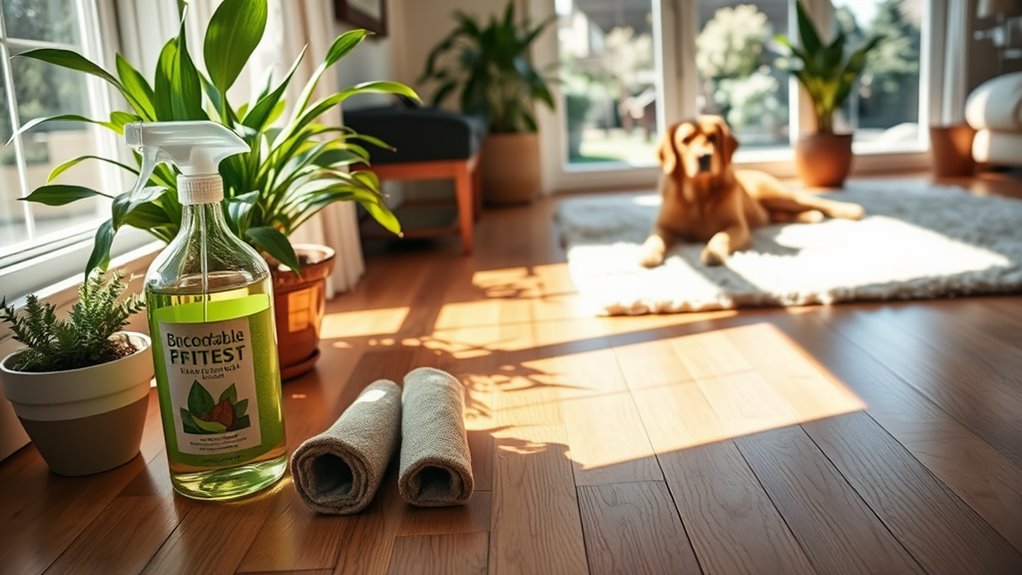
Maintaining a clean home for your pets often involves more than just regular cleaning routines; it also means choosing the right products to guarantee both effectiveness and safety. Eco-friendly cleaning options not only help you tackle pet stains, but they also support sustainable practices that benefit your home and the environment.
Consider using certified eco-friendly products like FIT Organic Pet Stain & Odor Remover, which utilizes organically certified ingredients without harmful chemicals. You'll appreciate that it's gentle on surfaces and safe for your furry friends.
Another great choice is Puracy Pet Stain Remover, boasting a 99.52% natural formula that's ten times more concentrated than competitors. Its plant-based enzymes effectively break down stains and odors.
Incorporating natural deodorizers, such as baking soda, can further enhance your cleaning routine. Simply sprinkle it on affected areas, let it soak, and vacuum it up to neutralize odors swiftly. Additionally, consider exploring DIY herbal carpet cleaners that utilize natural ingredients for effective and safe cleaning options.
When to Call Professionals
Recognizing the right time to call in professionals can save you a lot of stress and effort. If you're dealing with deeply set stains that resist your best home cleaning methods, it's a clear signal that professional intervention is needed.
Strong, lingering odors and older stains that have penetrated deeply into carpets or upholstery are also signs that you should seek expert help.
If you've already made several unsuccessful attempts to remove a stain, don't hesitate to reach out to professionals. They've specialized equipment and expert knowledge to conduct a thorough stain assessment, ensuring they tackle the problem effectively.
Consider comparing services when choosing a professional. Look for those with experience, positive customer reviews, and certifications in cleaning techniques. Additionally, professionals can employ advanced carpet cleaning techniques to ensure that even the toughest stains are addressed.
Eco-friendly options are also worth exploring if you're concerned about your pets' health and the environment.
Ultimately, professionals not only save you time but also provide long-term solutions that prevent stains from recurring. By investing in professional cleaning, you're protecting your home and ensuring a fresher, cleaner living space for both you and your beloved pets.
Frequently Asked Questions
How Can I Discourage My Pet From Urinating Indoors?
To discourage your pet from urinating indoors, focus on indoor training and behavior modification. Use positive reinforcement for correct elimination, keep areas clean, and address any underlying issues to help retrain their habits effectively.
What Type of Carpet Is Best for Homes With Pets?
For homes with pets, choose carpets made from durable materials like nylon or olefin, ensuring stain resistance. Look for options with low pile or built-in treatments to make cleaning easier and maintain a fresh environment.
Can Pet Urine Stains Cause Long-Term Damage to Carpets?
Yes, pet urine stains can cause long-term damage to carpets. The lingering urine odor might encourage repeat accidents, leading to potential carpet replacement. Acting quickly with proper cleaning methods is essential to avoid further issues.
How Often Should I Clean My Carpets if I Have Pets?
If your carpets are like a time bomb waiting to go off, you need to clean them regularly. Aim for vacuuming 2–4 times a week and deep clean every 2–6 months for ideal carpet maintenance.
Are There Any Home Remedies to Prevent Pet Stains?
To prevent pet stains, use a vinegar solution to clean immediately and sprinkle baking soda to absorb odors. Regularly apply this method, and your home will stay fresher and cleaner, reducing stubborn stains and smells.
Conclusion
In the battle against pet stains, remember: "An ounce of prevention is worth a pound of cure." By understanding your pet's habits and staying proactive, you can keep your home fresh and clean. Use the tips from this guide to tackle stains effectively, and don't hesitate to seek professional help when needed. With a little effort and the right approach, you can create a welcoming space for both you and your furry friends.

